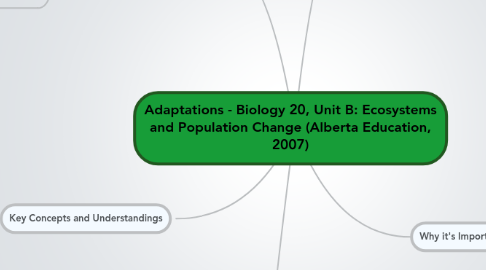
1. Key Concepts and Understandings
1.1. Natural Selection
1.2. Genotype vs. Phenotype
1.3. Adaptation and variation
1.4. Population
1.5. Species/speciation
1.6. Evidence for evolution
1.7. Heritable mutations
1.8. Modern evolutionary theories
1.8.1. punctuated equilibrium
1.8.2. gradualism
2. Difficulties/Misconceptions
2.1. Difficulties
2.1.1. Natural Selection (Kampourakis, 2006)
2.1.2. Religion's influence on understanding evolution (Alters, 1999)
2.2. Misconceptions
2.2.1. mutations are caused by environmental influences (Ferrari, 1998)
2.2.1.1. Subscribe to Lamarckian Theory
2.2.2. Darwin discovered evolution (McComas, 1997)
2.2.3. Teleological explanations about traits (Yip, 2009)
2.2.3.1. attempting to explain biological phenomena based on the ends they serve rather than on the cause
2.2.3.1.1. Example: Teleology - mammalian eyes work they way they do so that we can see on land well; Causal - mammalian eyes work the way they do because of random mutations that were selected for because they helped early mammals survive
3. References
3.1. Alberta Education. (2007). Biology 20-30 [Program of Studies]. [Edmonton], Canada: Alberta Learning.
3.2. Alters, B.J. (1999). What is creationism? The American Biology Teacher, 61(2), 103-106.
3.3. Ferrari, M., & Chi, M. H. (1998). The Nature of Naive Explanations of Natural Selection. International Journal Of Science Education, 20(10), 1231-56.
3.4. Kampourakis, K. (2006). The finches’ beaks: Introducing evolutionary concepts. Science Scope, 29(6), 14-17.
3.5. McComas, W. F. (1997). The Discovery and Nature of Evolution by Natural Selection: Misconceptions and Lessons from the History of Science. American Biology Teacher, 59(8), 492-500.
3.6. Yip, CW. (2009). Causal and teleological explanations in biology. Journal of Biological Education, 43(4), 149-151.
4. Why it's Important
4.1. Bio 30, Unit C: Cell Division, Genetics, and Molecular Biology
4.1.1. Mendel's Laws of Heredity
4.1.1.1. Dominant and Recessive
4.1.2. Mutations
4.2. Bio 30, Unit D: Population and Community dymamics
4.2.1. Natural Selection
4.2.2. Gene Pool
4.2.3. Determiners of Population size: natality, morality, immigration, emmigration
4.2.4. Hardy-Weinberg Principle
5. Previous Knowledge
5.1. Grade 7 science, Unit A: Interactions and Ecosystems
5.1.1. Extinction and Endangered Species
5.1.2. Interactions and Interdependencies
5.1.3. Species Distribution
5.2. Grade 8 Science, Unit E: Freshwater and Saltwater systems
5.2.1. Adaptations to aquatic ecosystems
5.2.2. Human impact
5.3. Grade 9 Science, Unit A: Biological Diversity
5.3.1. Species
5.3.2. Species diversity
5.3.3. Population
5.3.4. Sexual and asexual reproduction
5.3.5. Inheritance
5.3.6. Introduction to genetics
5.3.7. Natural and artificial selection
5.3.8. Symbiosis
5.3.9. Dominant and recessive characterisitics
